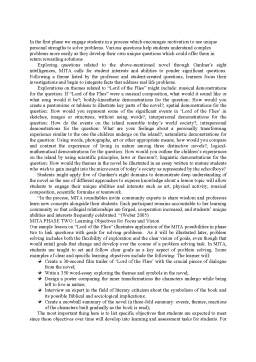Extras din referat
In 1983, Howard Gardner introduced his Theory of Multiple Intelligences in a seminal book, Frames of Mind. Based on his work as professor in the Harvard Graduate School of Education, his work as a psychologist researching brain injuries, and his long interest and involvement in the arts, he suggested that individuals have multiple intelligences rather than a single one and the potential to harness and develop all of them is possible. In his book, Gardner described seven equal and autonomous intelligences and more recently he has added an eighth and discussed the possibility of a ninth. The MI’s that he proposed are linguistic, logical mathematical, spatial, bodily kinaesthetic, musical, intrapersonal, interpersonal, and naturalist.
“In his theory of multiple intelligences (MI theory), Gardner sought to broaden the scope of human potential beyond the confines of the IQ score. He seriously questioned the validity of determining intelligence through the practice of taking individuals out of their natural learning environment and asking them to do isolated tasks they’d never done before ( ) Instead, Gardner suggested that intelligence has more to do with the capacity for (1) solving problems and (2) fashioning products in a context rich and naturalistic setting.” (Armstrong 2009) Another aspect he refers to is that we all learn in different ways and by different approaches and educators need to implement specific learning and teaching methods during the learning process.
Gardner grouped the different capabilities that humans possess in the following eight comprehensive categories or ‘intelligences’ as he called them:
Linguistic intelligence refers to an individual's capacity to use language effectively as a means of expression and communication through the written or spoken word (e.g.: poets, playwrights, editors, or journalists). Logical-mathematical intelligence refers to an individual's capacity to recognize relationships and patterns between concepts and things, to think logically, to calculate numbers, and to solve problems scientifically and systematically. (e.g.: mathematicians, economists, lawyers and scientists). Visual-spatial intelligence refers to the capability to think in images and orient oneself spatially. In addition, spatially intelligent people are able to graphically represent their visual and spatial ideas. This intelligence involves sensitivity to color, line, shape, form, space, and the relationships that exist between these elements. (e.g.: artists, decorators, architects, pilots, inventors). Bodily-kinesthetic intelligence refers to the capacity of using one's own body skillfully as a means of expression or to work with one's body to create or transform objects (e.g.: dancers, actors, athletes, sculptors, and craftspeople). Musical intelligence refers the capacity to perceive (e.g., as a music aficionado), discriminate (e.g., as a music critic), transform (e.g., as a composer), and express (e.g., as a performer) musical forms. Musically intelligent people are perceptive to elements of rhythm, melody, and pitch (e.g.: singers, musicians, and composers). Interpersonal intelligence refers to the capacity to appropriately and effectively communicate with and respond to other people. The ability to work cooperatively with others and understand their feelings (e.g.: counselors, politicians, talk show hosts, etc.). Intrapersonal intelligence refers to the capacity to accurately know one's self, including knowledge of one's own strengths, and limitations, awareness of inner moods, motivations, goals, and feelings; the capacity for self-discipline, self-understanding, and self-esteem (e.g.: entrepreneurs, psychotherapists, philosophers, etc.). Naturalist intelligence refers to the capacity to identify and classify the components that make up our environment, as well as sensitivity to natural phenomena (clouds, rock configurations) (e.g. naturalists, biologists, geologists, geographers, etc).
Gardner points out that we can best see the intelligences working at their zenith by studying the “end-states” of intelligences in the lives of truly exceptional individuals. For example, we can see musical intelligence at work by studying Beethoven’s Eroica Symphony, the naturalist intelligence through Darwin’s theory of evolution, or spatial intelligence via Michelangelo’s Sistine Chapel paintings.
The Multiple Intelligence Teaching Approach
MI theory makes its greatest contribution to education by suggesting that teachers need to expand their repertoire of techniques, methods, and strategies beyond the typical linguistic and logical ones predominantly used in classrooms all over the world. The way students engage with learning and take in new information can be improved by making use of these multiple intelligences.
A five-phase model – the Multiple Intelligence Teaching Approach (MITA) – developed by Weber, can be employed in the classroom to reinforce learning and get students involved in solving complex problems in authentic situations. Traditional schools and colleges “tend to neglect active student involvement, and so fail to tap their rich wells of diversity in class. When lessons do not accommodate students’ interests and abilities as tools to achieve, learners lose interest and feel disengaged”. (Weber 2005) A ‘Multiple Intelligence Teaching Approach’ blends Gardner’s (1983) vision of a wider range of intelligences and problem based learning (PBL) enabling students to learn actively using all their intelligences.
MITA or Multiple Intelligence Teaching Approaches for PBL is presented here as one response to enhance enjoyable learning opportunities for more and more students as research has shown that students understand better when they investigate authentic, real world problems, rather then simply memorize isolated facts for standardized tests.
The MITA model consists of a five-phase strategy to facilitate students’ learning through engaging their strengths, both individually and in collaboration with others. A MITA lesson on “Lord of the Flies,” by William Golding will serve to explain how this model works in the classroom. The novel we have chosen is a modern classic dealing with the ever-topical and universal themes of violence, social control, human nature and survival in rough conditions. The characters are some schoolboys who have been removed from their own context to be placed in elemental conditions, in a setting neither culture-specific nor restricted to one time, which would reveal eventually their true primitive selves.
Preview document
Conținut arhivă zip
- Multiple Intelligence Teaching Approach.doc









